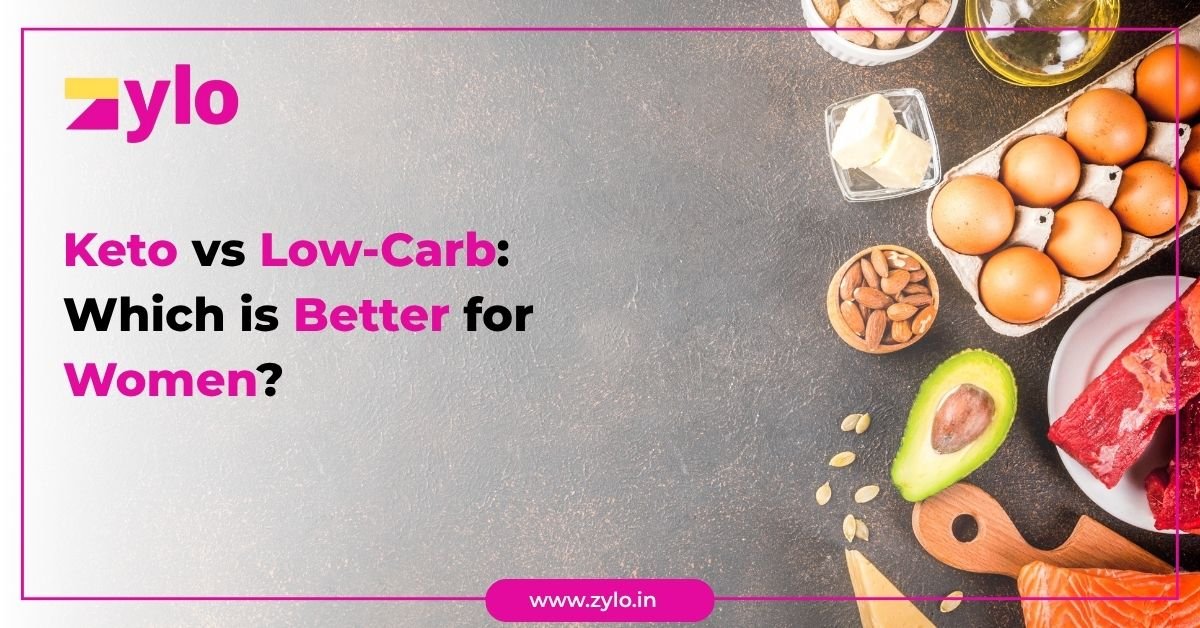In the search for effective weight loss, two diets often dominate the conversation: Keto and Low-Carb. Both restrict carbohydrates and promise fat loss, better energy, and improved health. But when it comes to choosing the right path, especially for women, the decision isn’t always simple.
Hormonal balance, lifestyle, metabolism, and personal preferences play a huge role in what works. So how do you choose? In this article, we’ll break down the key differences between Keto and Low-Carb, their pros and cons for women, and how to support either diet with practical choices like a healthy breakfast Indian for weight loss.
What Is a Low-Carb Diet?
A Low-Carb diet limits your daily carbohydrate intake, usually to around 50–150 grams per day. It encourages more protein and healthy fats, while reducing sugars, bread, rice, and processed carbs.
Key Components:
- Moderate protein (lean meats, paneer, tofu).
- Low to moderate fat (ghee, olive oil, avocado).
- Limited grains (quinoa, oats).
- Plenty of vegetables.
- Small servings of fruits (berries, apples).
This diet is flexible and less extreme than Keto, making it easier to stick to long-term.
What Is the Keto Diet?
The Ketogenic diet is a high-fat, very low-carb plan that aims to put your body into ketosis—a metabolic state where it burns fat instead of carbs for energy. Daily carb intake is typically restricted to 20–50 grams, and fat makes up about 70–75% of your calories.
Key Components:
- High-fat foods (butter, coconut oil, cheese, nuts).
- Moderate protein.
- Very low-carb (almost no grains or fruits).
- Non-starchy vegetables (spinach, broccoli).
Keto requires a stricter eating style and more planning to maintain.
Keto vs Low-Carb: Key Differences for Women
Let’s compare the two approaches in terms of how they affect a woman’s body, lifestyle, and long-term health.
Which One Supports Women’s Health Better?
Every woman’s body is different, but here are a few things to consider:
Hormones and Reproductive Health
Women’s hormones are sensitive to extreme dietary changes. Very low-carb Keto may disrupt menstrual cycles in some, especially if calorie intake is also too low. Low-Carb diets are generally safer for hormone balance when they include:
- Healthy fats.
- Sufficient calories.
- Whole foods.
PCOS and Insulin Resistance
Both diets can help with PCOS, insulin resistance, and belly fat. Keto can show rapid results in managing blood sugar levels, but Low-Carb offers a more sustainable approach for many women with fewer risks.
Lifestyle Compatibility
Keto can be hard to follow in an Indian context, where carbs are a staple. Low-Carb diets, on the other hand, allow more room for traditional meals—like dal, or roti (in moderation).
Long-Term Sustainability
Low-Carb is easier to maintain socially and mentally. Keto may cause fatigue, nutrient deficiencies, and social challenges over time unless carefully managed.
How to Choose: Ask Yourself These 5 Questions
- Do you need fast results or lasting change?
- If fast: Try Keto short-term.
- If sustainable: Low-Carb is better.
- Can you live without rice, roti, or fruit long-term?
- If yes: Keto might work.
- If not: Low-Carb is a better fit.
- Do you have time to plan and prep strict meals daily?
- Keto requires more effort.
- Are you physically active or doing intense workouts?
- Low-Carb supports energy better for active women.
- Do you have thyroid or hormonal imbalances?
- Stick with Low-Carb unless advised by a doctor.
Sample Indian Meal Plan for Both Diets
Here’s how a day might look on both plans with an emphasis on a healthy breakfast Indian for weight loss.
Low-Carb Indian Meal Plan (Approx. 100g carbs/day)
Breakfast:
Moong chilla (2) with mint chutney + herbal tea
(A protein-rich, healthy breakfast Indian for weight loss)
Mid-morning Snack:
1 boiled egg + black coffee
Lunch:
Grilled paneer tikka + sautéed vegetables + 1 phulka (without ghee)
Snack:
Handful of roasted almonds
Dinner:
Dal + mixed vegetable sabzi + cucumber salad
Keto Indian Meal Plan (Approx. 30g carbs/day)
Breakfast:
Paneer bhurji with coconut oil + green tea
Snack:
Avocado cubes with lemon & salt
Lunch:
Butter chicken (no gravy) + spinach sautéed in ghee
Snack:
Boiled eggs with homemade mayo
Dinner:
Cauliflower rice with creamy mushroom curry
Smart Swaps for Indian Women
Whatever path you choose, small ingredient changes can make your diet more effective:
These swaps allow you to still enjoy Indian flavors without overloading on carbs.
Common Mistakes to Avoid
❌ Ignoring Vegetables on Keto
Veggies are essential for fiber, digestion, and hormones—even on Keto.
❌ Not Eating Enough Protein on Low-Carb
Women often under-eat protein, leading to fatigue and muscle loss.
❌ Going Zero-Carb on Both
Carbs are not the enemy—choose the right carbs like oats, quinoa, and fruits.
❌ Skipping Meals
Whether on Keto or Low-Carb, consistency is key. Skipping meals can spike cravings and affect metabolism.
Breakfast is Non-Negotiable
Whether you follow Keto or Low-Carb, starting your day with a nutritious, low-glycemic meal keeps insulin stable and cravings away.
Here are examples of Healthy Breakfast Indian For Weight Loss:
- Oats porridge with chia seeds and almonds (Low-Carb).
- Egg bhurji with spinach (Keto).
- Moong dal dosa with coconut chutney (Low-Carb).
- Paneer cutlets with flaxseeds (Keto).
- Greek yogurt with cinnamon and walnuts (Both).
Final Thoughts
Both Keto and Low-Carb diets can be effective tools in a woman’s weight loss journey, but they serve different needs. If you’re looking for a quick reset or have specific health conditions (like PCOS), Keto might give you that initial push. But for long-term health, hormonal balance, and lifestyle flexibility—Low-Carb wins the race.
The key is to listen to your body, choose a plan you can stick to, and support it with balanced, Indian-friendly meals that align with your goals. Whatever you choose, make sure it works for you. Because the best diet isn’t the most popular one—it’s the one that fits your life, your culture, and your long-term health.



